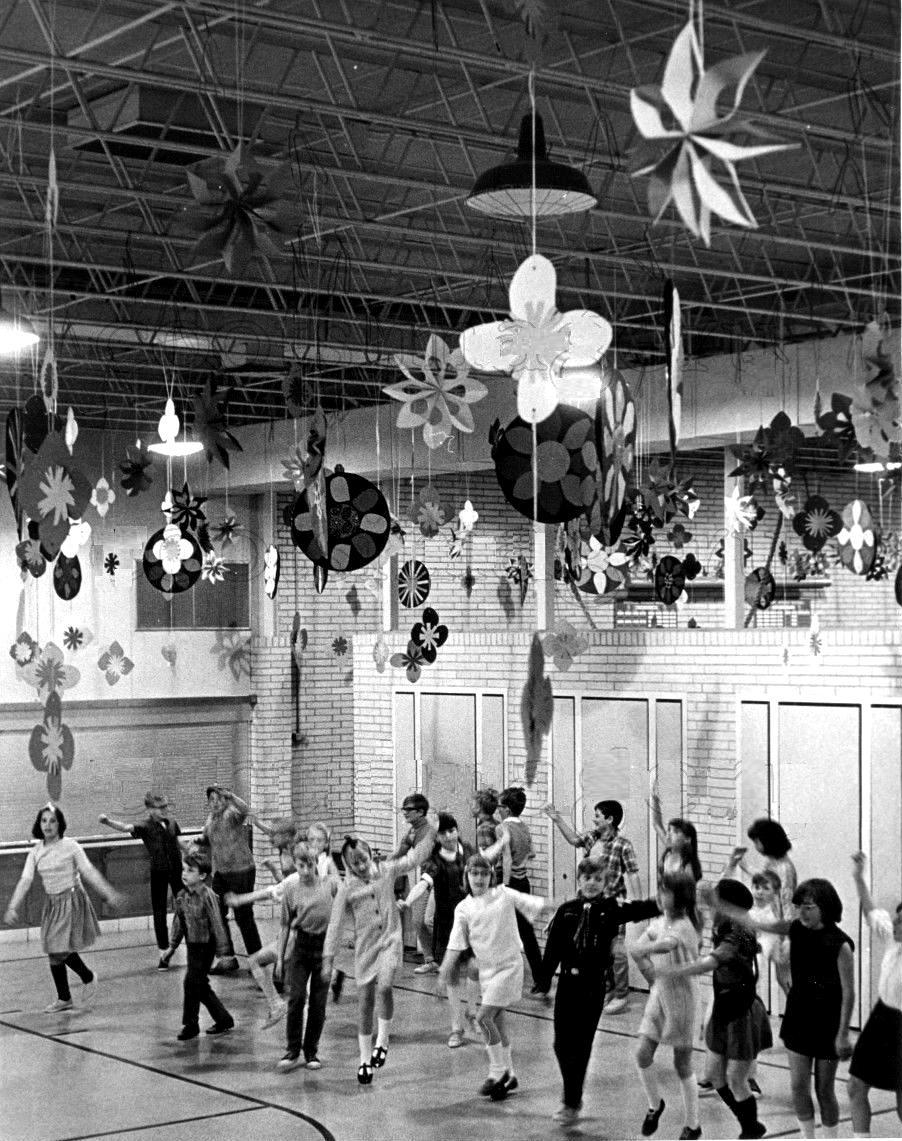
U.S. School Clothes: Bertha Heid Elementary School (Colorado, 1969)

Figure 1.--Here we see a dnce demonstration as part of an arts festival at a Colorado primary school. A press caption read, "Bertha Heid School Flies Mobiles: These mobiles under which the children are dancing are only a few of artifacts on display in Berth Heid Elementary School. , E. 91st Ave. and Poze Blvd., Thorton [near Denver]. The occasion for the 1,300 mobiles, pictures on all available wall spce in the hallway, butterflys on corridor ceilings , and sculpture and ceramics perched everywhere, is schools annual art show. The public art exhibit is by students of Mrs. Alice Pavlisin and Mrs. Kathryn Hoggard. Art is work of first-fourth grade." Notice the Cub Scout and Brownie. The photograph is dated April 30, 1969.
|
|
Here we see a dance demonstration as part of an arts festival at a Colorado primary school. A press caption read, "Bertha Heid School Flies Mobiles: These mobiles under which the children are dancing are only a few of artifacts on display in Bertha Heid Elementary School, E. 91st Ave. and Poze Blvd., Thorton [near Denver]. The occasion for the 1,300 mobiles, pictures on all available wall space in the hallway, butterflys on corridor ceilings, and sculpture and ceramics perched everywhere, is schools annual art show. The public art exhibit is by students of Mrs. Alice Pavlisin and Mrs. Kathryn Hoggard. Art is work of first-fourth grade." Notice the Cub Scout and Brownie. The photograph is dated April 30, 1969. Thorton was a farming area until after World War II after which it began to develop as a suburban area for the growing Denver municipal area. Incomes were above average and it became a middle-class community. It is a good example of the attention given to art and extra-curricular activity in American schools. Such non-academic activities was an important part of the curriculum at American schools. This seems to be an especially important arts festival, but similar if not as elaborate events were organized at many other American schools. The children here are dancing, but notice they have not paired off. We also get a good idea of popular American suburban school fashions at the time. The girls still mostly wore dresses ans skirts. Knee socks were popular. We can see the short-length skirts that were beginning to become popular. Boys mostly wore collar shirts and to some extent T-shirts and long pants. Cubs and Brownies often wore their uniforms on special days. Boys almost never wore short pants to school even when the eather begn to warm up, except the very youngest. This was only beginning to change.
HBC

Related Chronolgy Pages in the Boys' Historical Web Site
[Main Chronology Page]
[The 1900s]
[The 1910s]
[The 1920s]
[The 1930s]
[The 1940s]
[The 1950s]
[The 1960s]
[The 1970s]
[The 1980s]
[The 1990s]
[The 2000s]
Navigate the Relate Boys Historical Clothing Style Pages
[First Communion]
[Confirmation]
[Long pants suits]
[Short pants suits]
[Kneepants]
[Knickers]
[Kneesocks]
[Long stockings]
[Eton suits]
[Jacket and trousers]
[Button-on clothing]
[Blazer]
[School sandals]
[Bangs]
Navigate the Boys' Historical Clothing School Uniform Pages
[Return to the Main U.S. individual school H-L page]
[Return to the Main U.S. individual school 1960s page]
[Return to the Main U.S. individual school chronology page]
[Return to the Main American public school dance activities]
[Return to the Main national school page]
[Return to the Main girls 1960s chronology page]
[Return to the Main American 1960s Cub page]
[Australia]
[England]
[France]
[Germany]
[Ireland]
[Italy]
[Japan]
[New Zealand]
[Poland]
[Singapore]
[Scotland]
[Singapore]
Navigate the Boys' Historical Clothing Web Page
[Introduction]
[Activities]
[Biographies]
[Chronology]
[Clothing styles]
[Countries]
[Girls]
Musical instruments]
[Bibliographies]
[Contributions]
[FAQs]
[Glossaries]
[Images]
[Registration]
[Tools]
[Boys' Clothing Home]
Created: 3:14 PM 1/2/2019
Last updated: 3:14 PM 1/2/2019




